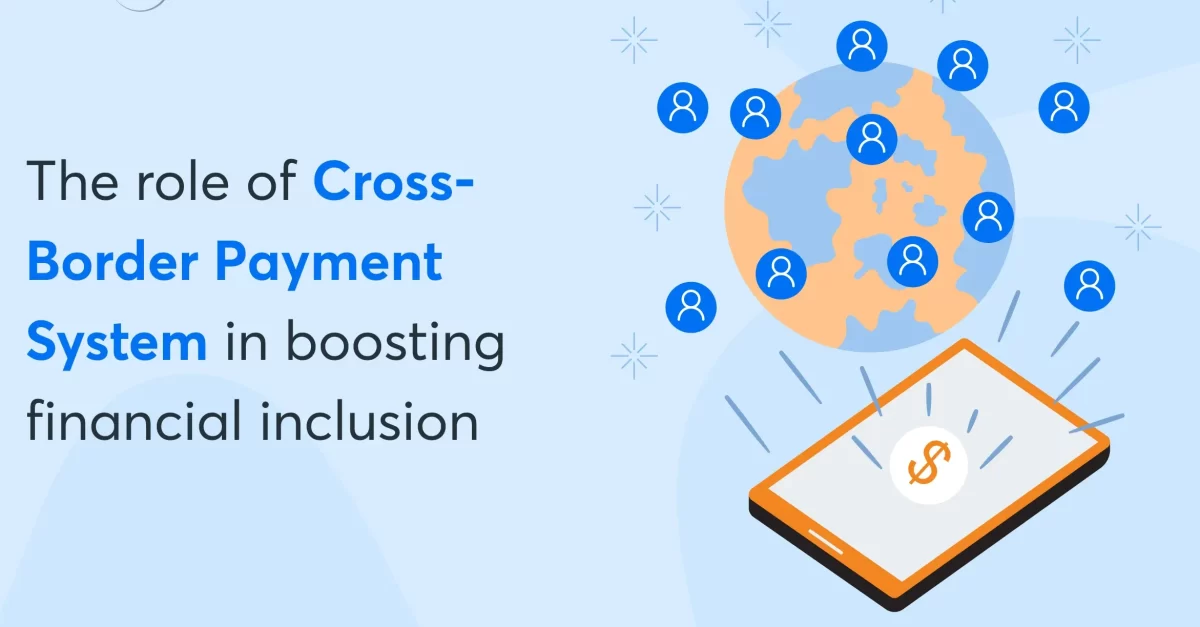Boosting global financial inclusion with cross border payment solutions

Achieving global financial inclusion is crucial for driving economic growth, reducing poverty, and fostering social empowerment worldwide. Still, a huge number of the global population lack access to basic financial services. Cross-border payment solutions facilitate seamless and affordable international transactions, enabling underserved populations to access financial services, conduct business, and participate in the global economy. This helps boost financial accessibility significantly and makes the unbanked and underserved population feel more financially inclusive.
In this blog, you will explore the transformative potential of cross-border payment solutions in boosting global financial inclusion.
Let’s straight right into it!
Understanding global financial inclusion
Financial inclusion means making sure everyone, especially those with low income or in remote areas, can easily use banking services like savings accounts, loans, and insurance. It helps people manage money better and participate in the economy.
Trying to achive global financial inclusion is a global concern. So. let’s understand where the financial inclusion scenario stands right now and its challenges:
Current state of financial inclusion worldwide
Despite concerted efforts, a significant portion of the global population, particularly in developing countries, remains financially excluded. This is due to geographical barriers, lack of infrastructure, socioeconomic disparities, and limited access to formal financial institutions. This financial exclusion hinders economic growth and perpetuates the cycle of poverty.
Challenges hindering financial inclusion on a global scale
Geographical barriers: Remote and rural areas often lack access to physical bank branches or financial service providers, making it difficult for residents to access financial services.
Regulatory hurdles: Complex regulations and compliance requirements across jurisdictions can create barriers for financial institutions to expand their services to underserved populations.
Lack of infrastructure: Inadequate digital infrastructure, such as internet connectivity and mobile network coverage, can hinder the adoption of digital financial services in certain regions.
Socioeconomic factors: Poverty, low-income levels, and limited financial literacy can make it challenging for individuals to access and effectively utilize financial services.
Trust and cultural barriers: In some communities, there may be a lack of trust in formal financial institutions or cultural norms that discourage the use of banking services.
Impact of financial exclusion on individuals and economies
Financial exclusion;
- Continues the cycle of poverty
- Limits opportunities for entrepreneurship & economic growth
- Increases vulnerability to economic shocks
- Deepens social & economic marginalization within societies.
That’s where cross-border payment solutions come into play to ease the financial inclusion barriers through its advanced technologies and features for sending and receiving money from across the globe.
Role of cross-border payment solutions in financial inclusion
Cross-border solutions play a crucial role in boosting financial inclusion. Here’s how!
Accessibility: How cross-border payment solutions can reach underserved populations
Cross-border payment solutions can leverage existing telecommunications networks and decentralized infrastructures to provide financial services in remote and underserved areas, where traditional banking infrastructure may be limited or nonexistent.
Affordability: Cost-effectiveness of cross-border transactions compared to traditional methods
By streamlining processes and leveraging innovative technologies, cross-border payment solutions can offer lower transaction fees compared to traditional methods, making international transactions more affordable for individuals and businesses.
Security: Ensuring the safety of cross-border transactions for users
Advanced security measures, such as encryption, fraud detection mechanisms, and secure authentication protocols, are employed by cross-border payment solutions to ensure the safety and integrity of international transactions.
Speed: Accelerating the pace of financial transactions globally
Cross-border payment solutions can significantly accelerate the process of sending and receiving funds across international borders, reducing transaction times and enabling faster access to funds for recipients.
Overcoming challenges to implementation of cross-border payment solutions
Regulatory hurdles and compliance issues
Navigating complex regulations and compliance requirements across multiple jurisdictions remains a significant challenge in implementing cross-border payment solutions, requiring close collaboration with regulators and policymakers.
Technological barriers and infrastructure limitations
Limited digital infrastructure, including inadequate internet connectivity and mobile network coverage, can hinder the adoption and successful implementation of cross-border payment solutions in certain regions.
Addressing concerns related to privacy and data security
Ensuring robust data privacy and security measures is crucial to building trust and encouraging widespread adoption of cross-border payment solutions, as concerns over data breaches and cyber threats persist.
Collaborative efforts needed for successful implementation
Successful implementation of cross-border payment solutions requires collaborative efforts among financial institutions, technology providers, regulators, and other stakeholders to address challenges, drive adoption, and create an enabling ecosystem.
Future Trends and Opportunities of cross-border payments boosting financial inclusion
Emerging technologies shaping the future of cross-border payments (e.g., AI, IoT)
Emerging technologies such as artificial intelligence (AI) and the Internet of Things (IoT) are poised to revolutionize the cross-border payments landscape.
AI can facilitate real-time fraud detection, risk management, and personalized financial services, while IoT enables seamless cross-border transactions for connected devices, expanding the reach of financial inclusion.
Potential partnerships and collaborations to enhance global financial inclusion
Strategic partnerships between financial institutions, fintechs, and technology providers can drive innovation and expand the reach of cross-border payment solutions to underserved populations.
Collaborations with local communities, non-governmental organizations, and government agencies can help tailor solutions to specific needs and cultural contexts, ensuring widespread adoption and relevance.
Predictions for the future landscape of cross-border payment solutions
The future landscape of cross-border solutions is expected to be increasingly decentralized, leveraging blockchain and distributed ledger technologies for enhanced transparency, security, and efficiency.
Real-time cross-border transactions, interoperability between different payment systems, and robust data privacy and security measures will be key focus areas as the industry evolves.
Conclusion
This blog has explored the pivotal role of cross-border solutions in enhancing global financial inclusion. It examined the current state of financial inclusion worldwide, highlighting the challenges hindering its progress, such as geographical barriers, regulatory hurdles, and socioeconomic disparities.
The advantages of cross-border solutions in terms of accessibility, affordability, security, and speed were discussed, showcasing their potential to bridge the gap between underserved populations and essential financial services.
Cross-border solutions hold transformative potential in promoting global financial inclusion. By facilitating seamless and cost-effective international transactions, these innovative solutions can empower individuals and businesses worldwide to participate in the global economy, driving economic growth, reducing poverty, and fostering social empowerment.








